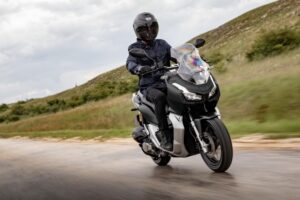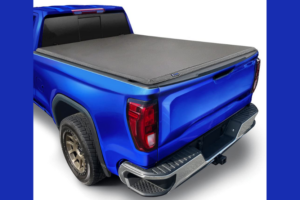Kawasaki introduced the Ninja 300 sport bike in 2012 to replace the Ninja 250R. The 300 left an impressive mark, with many stores selling the 300 in place of the 250R.
The Kawasaki Ninja 300 has an incredible appeal that has attracted bikers who want additional power and enjoy an easy ride.
The Ninja 300 offers a more durable frame, a 6-speed transmission gearbox, a 785 mm-high seat, and a 2-cylinder engine that provides 39.4 horsepower and 27 Nm torque at 10,000 RPM.
The Kawasaki Ninja 300’s top speed is 171 – 192 km/h (106 – 119 mph).
Read on to learn more about the Kawasaki Ninja 300 specs, and its pros and cons.
About the Kawasaki Ninja 300
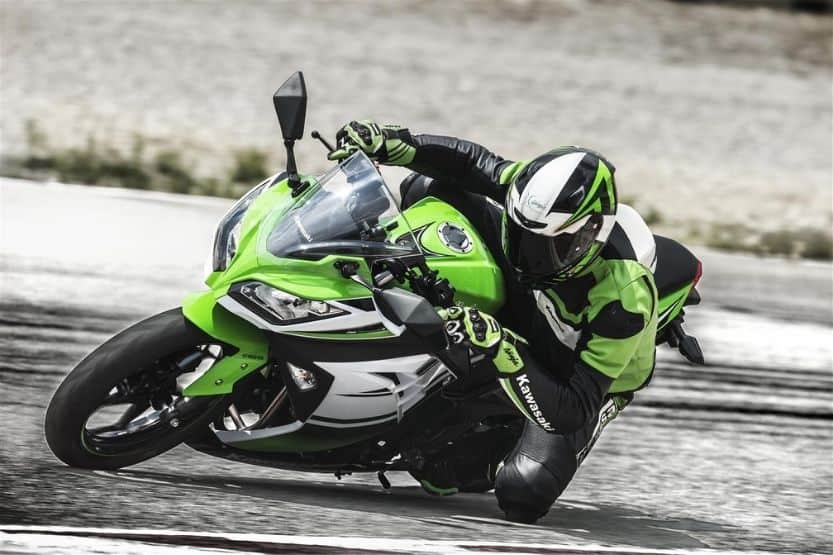
Bikers who want additional power and a smooth ride find the Kawasaki Ninja 300 to be a great choice. The Kawasaki Ninja 300 offers the following:
- Durable frame
- 6-speed transmission gearbox
- 785 mm high seat
- Two-cylinder engine (39.4 HP and 27Nm torque at 10 000 RPM)
The Kawasaki Ninja 300 gained popularity because it is lightweight and reliable with easy maneuvering. The 300 weighs 164 kg (362 lbs) dry and 174.6 kg (385 lbs) wet. A liquid fuel injection powers the Kawasaki Ninja 300, ensuring its smooth operation.
It also features an EX300ADF ignition that provides a significant improvement from the 250R. This model series sold well in North America, Asia, Europe, and Australia alongside the 250R. But some stores have replaced the old 250R with the new Ninja 300.
A few customers claimed that the 2013 Kawasaki Ninja 300 engine had an internal fault that could stall the engine. An ECU installation solved this small problem.
The 2014 Kawasaki Ninja 300 is similar to its predecessor, but the rare issues with the 2013 series were resolved. Also, the company added other colors that customers can choose from. The 2015 Kawasaki Ninja 300 came along with no significant differences from the 2014 model.
Nevertheless, the ABS compatibility issues were finally resolved as the company rolled out the 2016 Kawasaki Ninja 300 and the 2017 Kawasaki Ninja 300 models. The new Ninja 300 sported trendy colors, such as Ninja green, red, and black.
In 2018, the Ninja 400 was introduced to the market, and the Ninja 300 has a new replacement. However, motorcycle riders continue to buy the 300 as it is cheaper but still reliable.
Kawasaki Ninja 300 Specifications and Features
1. Engine
The Ninja 300 or EX300 provides a 2-cylinder engine that can contain 296 cc of fuel. Its oil filter is cartridge-designed with different sleeveless cylinders, conrods, and pistons from the 250.
The fuel-injection-system engine features a 4-stroke parallel twin that is liquid-cooled. The 300’s engine also provides 39.4 hp of power and 27 Nm of torque at 10,000 RPM. Its maximum power is 38.4 bhp at 11,000 RPM.
2. Dimensions
The Kawasaki Ninja 300 is 715 mm (28.1 in) wide, 2015 mm (79.3 in) long, and 1,110 mm (44 in) high. Its wheelbase is 1405 mm (55.3 in), and its seat height is 785 mm (30.9 in). This dimension is unlike any other, putting the 300 at the forefront of safe and comfortable motorcycles.
3. Exterior
The 2013 Ninja 300 looks sleek and powerful with its various colors. You can choose from candy plasma blue, lime green, lime green/ebony, and ebony/metallic moor. It is ergonomically designed for novice riders of all sizes with its convenient seat height.
4. Tires
The 10-spoke wheel design and the 17-inch wider tires increase stability and endurance. The front tire’s size is 110/ 70-17 MC (54W), while the rear tire’s size is 140/ 70-17 MC (66S). The Ninja 300 tires perform better on wet and slippery roads than the 250R due to its new IRC RX-01R tires.
5. Powertrain
The Ninja 300’s modified transmission provides shifting gears powered by the fuel injection system engine. The 4-stroke parallel engine utilizes a 6-speed transmission system that allows an easier and smoother shifting of gears.
The petal disk brakes deliver smooth high-powered performance and reliability. It is a 6-speed, slipper catch chain that features additional stability.
6. Suspension
The rear track suspension offers a 5-way adjustable preload design. This system helps stabilize the ride height, whether you are riding alone or with a passenger.
The rear suspension also offers a bottom-link Uni-Trak link, while the front suspension provides wheel travel with a 37-mm telescopic fork.
7. Lighting
The 300’s stylish dual-lamp headlights lend a modern touch to the motorbike. Its rear lights add not only a needed precautionary measure but also a significant finishing touch.
8. Brakes
Kawasaki designed the Ninja 300’s front brakes with a 290 mm single petal disc and a balanced dual piston. The rear brakes comprise a single 220 mm petal disc equipped with a dual-piston. The anti-lock braking system offers another option that could assist a rider in stopping in an emergency.
9. Ignition
The motorbike’s digital ignition provides two tamper-resistant bolts, enhancing its security features. Its Capacitor Discharge Ignition (CDI) capability fires the spark plugs by utilizing the coil’s capacitor discharge current.
10. Unique Features
Kawasaki introduced many unique features with the introduction of the Ninja 300 in 2013. These features include a larger and more powerful motor, a new wider rear tire, and an Assist and Slipper Clutch.
The new pegs, modified suspension, clocks, radiator fan cover, and a more durable frame add to its trendy look. An LCD instrumentation completes the updated technology.
11. Kawasaki Ninja 300 Top Speed
The Kawasaki Ninja 300’s top speed is 171 – 192 km/h (106 – 119 mph). A 29 kW (39 hp) at 11,000 rpm powers this incredible speed. However, you will have to work hard to take the engine to its highest speed.
You have to keep the motor spinning by frequent ships of the 6-speed gearbox. Once there, it would be a smooth-riding along open A-roads.
Kawasaki Ninja 250 Speed and Other Features
Complete List of Pros and Cons of the Kawasaki Ninja 300
Pros
1. Efficient Assist and Slipper Clutch
The Ninja 300 features an efficient Assist and Slipper Clutch with two types of cam: the slipper cam and the assist cam. The slipper cam separates the operating plate and clutch hub apart, preventing the rear tire’s skidding and hopping.
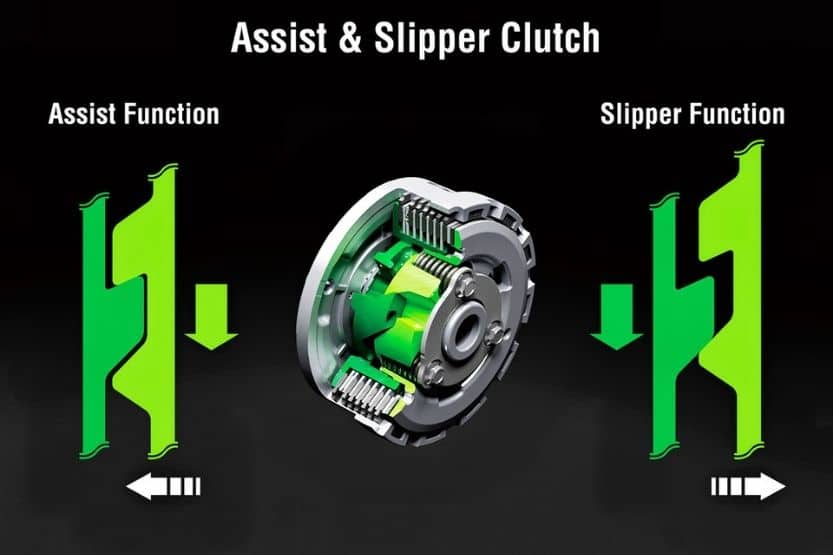
Meanwhile, the assist cam does the opposite; it pulls the operating plate and clutch hub together to reduce the spring load, allowing easier clutch operation.
2. Powerful Twin Motor
Compared to the Ninja 250R, the Ninja 300 has a powerful twin motor engine that can boost its maximum speed up to 192 mph (119 mph). The engine’s fuel injection system allows for easy and efficient combustion.
The 6-speed transmission is precise and works smoothly to provide efficient highway performance.
3. Provides Smooth and Excellent Ride
The EX300 is good for racing tracks due to its design and key features. It provides a smooth and excellent ride for professional and novice riders.
The motorbike’s powerful acceleration feature is outstanding as compared to other lightweight sports bikes. It holds well in faster corners and is less ‘bumpy.’
4. Reliable Brakes
You can count on the petal disc brakes to stop when you want them to stop. The brakes’ reliability is due to their petal disc design and dual-piston caliper grips.
5. Comfortable Ergonomics
Riders enjoy a comfortable ride because of the seat’s good height and its suitability to any body size. Kawasaki designed the sports bike not only for speed but also for fun riding.
6. Excellent Features
The Ninja 300 provides various excellent features, such as its multi-instrument console, dual lamp headlights, a LED taillight, durable material, and slick exterior.
Its distinct look sets it apart from other less trendy motorcycles in the segment. Its dashboard is sporty and trendy. The LCD panel features a speedometer, a clock, and the fuel level as well.
7. More Stable Ride
The EX300 is more stable than some motorbikes in its category due to its high ground clearance and wide wheelbase. These features improved its performance for slow or rapid turns. It is also stable along highways or city roads.
8. More Economical and Easy Maintenance
The 300 demonstrated improved gas mileage over the Ninja 250R. Its fuel economy measures at around 3.4L per 100 km, or 70 mpg.
Also, you could easily maintain the sportbike by yourself, except when removing fairings for certain repairs. Conducting regular shop maintenance, though, is a must.
Again, Kawasaki Ninja 300 draws both amateur and professional drivers’ attention due to its power and comfortable ride. It also has a durable frame, two-cylinder engine, a 6-speed transmission gearbox, among others.
Cons
1. Reduced Passing Power on Highway Speeds
Although the Ninja 300 is deemed wind-resistant at highway speeds, the Ninja’s passing power is still not higher than other motorcycles. You have to be cautious not to go over the speed that can cause mishaps.
This may be a common issue with most motorcycles, but the company could improve 300 to increase its passing power.
2. Costly in Other Regions
Some customers reported higher prices in a few regions. The price may be affected by the region’s economic factors, such as supply and demand. You may want to browse other models before deciding which product to buy.
We have discussed the Kawasaki Ninja 300 specs and review. Let’s now proceed to some frequently asked questions about the Ninja 300.
Is the Kawasaki Ninja 300 Worth Buying?
Yes, the Kawasaki Ninja 300 is worth buying, depending on your purpose. If your purpose is to use it as a means of transportation, you got yourself a winner.
The comfortable seating also makes it the best for beginners. Furthermore, its efficient heat management feature will keep you safe even during traffic jams.
Cost of the Kawasaki Ninja 300
The present model of the Kawasaki Ninja 300 is $19,000. But the price may vary according to your region. Visit the Kawasaki dealer’s website in your region before selecting your motorcycle.
Is Kawasaki Ninja 300 a Good Beginner Bike?
Yes, the Ninja 300 is a good beginner bike. As a sportbike, it has its advantages and disadvantages. Nonetheless, a beginner can easily adjust to its seemingly aggressive riding position. You can adjust the handlebar for a more comfortable position.
A beginner can enjoy a comfortable ride with its ergonomically designed seat too. The motorcycle is also light and handles well so that any rider can manage it.
Is the Kawasaki Ninja 300 Good for Long Rides?
Yes, the Ninja 300 is perfect for long rides. It can provide the power you need and is more economical than the Ninja 250R. But know your limits. Do not over-drive or over-tax the engine more than you should.
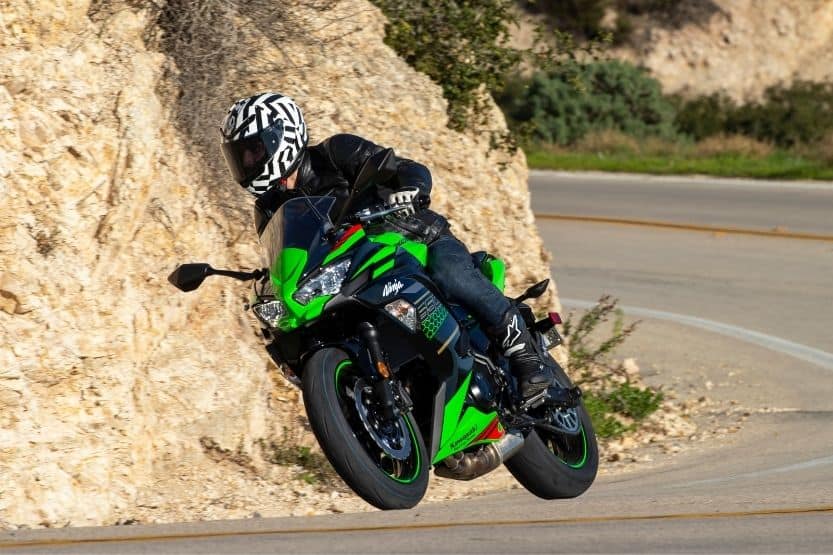
How Many Miles Will a Ninja 300 Last?
A well-maintained Ninja 300 can last up to 100,000 miles. Thus, it is crucial to maintain the good condition of your motorcycle.
Why Was the Ninja 300 Discontinued?
The Ninja 300’s discontinuation is only temporary. Reportedly, the BS6 version is in the pipeline. Meanwhile, the Ninja 400 is an outstanding replacement to watch out for. Recently, users voted the Ninja 400 as the Best Motorcycle for Beginners.
Tips for Maintaining Your Kawasaki Ninja 300
1. Do the Maintenance Yourself
You can do most of the minor maintenance yourself. Nevertheless, be alert and know your Ninja 300 well enough, so you can detect early issues. Check the engine, clutch, headlights, the horn, the throttle, and all the essential parts every time you head for the road.
This will save you a lot of costs yearly. You could visit the dealer’s shop every year to be sure that you are doing it right.
2. Service the Engine for Every 7,500 Kilometers
Do not overwork the engine. Although machines are not humans who can tire eventually, they also need rest. Overworking your engine can cause problems as parts can get damaged by over-usage. You must let a competent motorcycle technician check the engine every 7,500 kilometers.
3. Change the Oil Every 5,000 Kilometers
You should change the Ninja 300’s oil at least every 3 months or every 5,000 km. You will have to rev the bike frequently; hence, you have to change the oil regularly.
4. Change the Brake Fluid and Air Filter Every Two Years
If you want your engine and brakes to work smoothly, change the brake fluid and air filter, at least after every two years. Naturally, if there are problems before two years, you have to change them immediately.
Conclusion – Kawasaki Ninja 300
The Kawasaki Ninja 300 offers both power and a comfortable ride that appeals to professional and beginner motorcycle riders. The 300 features a more durable frame, a 785-mm high seat, a 6-speed transmission gearbox, and a 2-cylinder engine.
This engine provides 39.4 horsepower and 27 Nm torque at 10,000 RPM. The Ninja 300 is a perfect sports bike for beginners who want to enjoy quick transportation and a comfortable ride.
To help you maintain your Kawasaki Ninja 300, here are the tips you should take note of:
- Do the Maintenance Yourself
- Service the Engine for Every 7,500 Kilometers
- Change the Oil Every 5,000 Kilometers
- Change the Brake Fluid and Air Filter Every Two Years
Related reading:
Kawasaki Vulcan 500 Specs and Review
Kawasaki Eliminator 125 Specs and Review

![Kawasaki Ninja 250 Top Speed [How Fast Can It Go?] kawasaki ninja 250 top speed](https://roadsumo.com/wp-content/uploads/2022/06/Kawasaki-Ninja-250-top-speed-150x150.jpg)




![Noise When Braking at Low Speed [Causes and How To Fix] noise when braking at low speed](https://roadsumo.com/wp-content/uploads/2021/07/noise-when-braking-at-low-speed-150x150.jpg)
